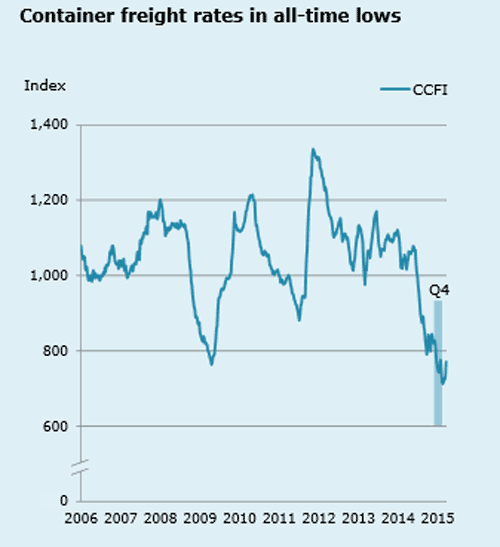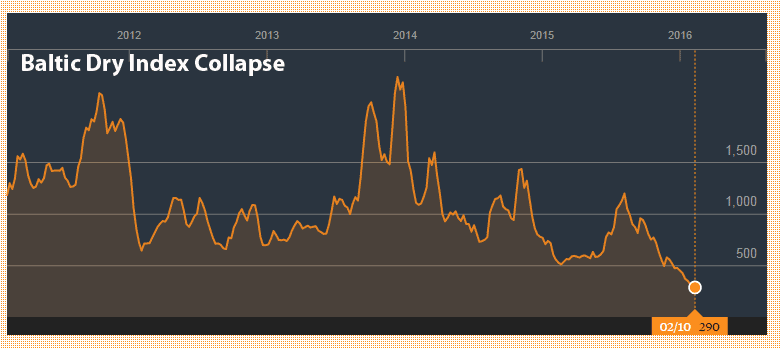We are living in some very strange economic times.
We could start with the "new normal" of lukewarm growth (2% or so) seemingly every year in the US, and barely positive growth if that in Europe. Nothing seems to change that trajectory.
Gilmore Says.... |
 |
| For the years before mid-2008, the corporate concern was on ever rising "input and logistics costs," often blamed for missing earnings targets.
Now, this scenario is simply turned on its head. |
 |
What do you say? |
|
| Click here to send us your comments |
| |
|
|
|
But that said, it seems like decent enough economic environment for most - so why is the price of everything collapsing?
I am going to let charts do most of the talking here, so let's start with oil. We all know the general story: oil was actually very steady in the $90-100 per barrel from 2011 through the first half of 2014, and then pow - a 70% or so drop to around $30 now for about three months. And of course, that is down 80% from $140 or so we saw in July of 2008. Chart here.
Diesel prices have followed suit, recently dropping below $2.00 per gallon for the first time since 2005. Where I am located in Ohio this week diesel was below gasoline prices per gallon - can't remember the last time that happened.
The same basic story for natural gas, where generally the price is lower in the US than most of the rest of the world. As you can see in this chart, natural gas prices have fallen from $6.61 per million BTUs in 2011 to about $1.75 currently - a decline of an astounding 74%.
Other commodities of all types are in retreat. The IHS Materials Price Index - which tracks a basket of commodities - is down about 60% just since July 2014, as shown below, and is now down past levels seen at the bottom of the Great Recession in 2009 to even lower 2003 levels - and yet we are not in a Great Recession.

As just a couple of examples of this outside of energy, you probably have heard of the collapse of steel prices, which have fallen by two-thirds since the $600 per ton level reached in early 2011 to about $200 today, as you can see here. Brutal. In June of 2008, the price was about $1265 - an amazing six times today's prices.
I don't have a chart, but many agricultural prices are also in the toilet. For example, wheat was $361 per metric ton in late 2012. It is now down more about 55% since then, at $164. It saw its all-time high of $439 in June of 2008 - nearly three times the current price.
Most of us know container shipping rates have also cratered, reaching modern all-time lows late in 2015, below variable costs to operate a ship and down by about 50% from 2012 levels, as you can see in the chart here that tracks the China Containerized Freight Index.

But perhaps the most astounding price story of all are the rates for bulk shipping of commodities, as is reflected in something called the Baltic Dry Index. In December 2013, that Index stood at 2330; it was at 290 this week- an almost unimaginable 88% decline.

What the hell is happening? Other things of course have held up - trucking and rail rates, for example, and thankfully wages for the most part.
But all this is wreaking much havoc, even if sometimes that pain is out of direct view. Oil-focused countries - most notably Russia - are facing economic disaster, and who knows what that will lead to. Commodity-dependent Canada quietly went into recession last year, and Brazil's economy is a mess. The whole US oil-natural gas fracking sector is in jeopardy - the growth of which had been a key factor in reaching just the modest 2% GDP growth we've seen in recent years.
The container shipping industry is madly consolidating. Bulk container lines are selling any asset they can just to "stay afloat" financially.
Steel giant ArcelorMittal lost $7.9 billion in 2015. Steel companies around the globe have been rapidly shedding workers. Steel sector employees - blue collar, managers, executives - just recently staged a mass march in Brussels to protest low cost Chinese imports they blame for the price collapse.
An article last week in the Farm Journal was headlined "Dilemma for U.S. Farmers: Which Crop Will Lose the Least Money?" Meanwhile, mining and agriculture woes are taking down great equipment companies like Caterpillar and Deere.
There are myriad and varying factors in all this, from a slowdown in Chinese demand (number one source of blame for most observers) to a strong US dollar to insane capacity growth in the shipping industry, etc.
But for the years before mid-2008, the corporate concern was on ever rising "input and logistics costs," often blamed for missing earnings targets.
Now, this scenario is simply turned on its head - and again, all this in decent economic times. What will happen if we do slide into recession? Could it get even uglier?
While lower gas costs are great for consumers, and lower input costs great for some (but certainly not all) businesses, I have to wonder if the markets - with prices worse than the bottom of the Great Recession - aren't telling us that an economic slowdown is indeed coming.
Maybe it is just supply and dermand at its most brutal, but we've never seen prices collapse like this in relatively good economic conditions in our lifetimes.
What is your take on these collapsing prices? Good or bad thing? Do you think it is signaling coming economic weakness? Where do you see things going from here? Let us know your thoughts at the Feedback section below.
Your Comments/Feedback
|
|
Craig LaFrance
NA, DWCC |
Posted on: Feb, 25 2016 |
|
|
From where we sit it's pretty straightforward. Demand is collapsing. What makes it difficult is if you listen to the major news media outlets we are doing fine. The numbers can be manipulated, massaged and spun. But the raw data is what it is. |
|
Gene Nusekabel
Logistics Manager, Retired |
Posted on: Feb, 25 2016 |
|
|
The reason no one can make an sense of it is that there has been no other time in history like this period. Why is that? All of the global technology and algorithms that now move the markets are beyond our ability to comprehend what is happening "behind the trading curtain". I cannot even imagine what computer trading signals "domino down" when the algorithms note the oil price dropped and trading begins.
Oil prices are related to market valuations today? That could be the case inside the algorithms as no TV pundits seem to understand if either. As a simple thinking human, I am still struggling to understand that a strong US dollar is bad for the US nowadays. It drags US stocks down because US companies are so dependent on international consumers to "buy stuff". If that is the case, I hope the Chinese government continues to encourage consumerism to their citizenry so my retirement fund grows. WE ARE ALL CONNECTED!
|
|
Ernest Miller
Managing Partner, OPTIO TEMPORE |
Posted on: Feb, 25 2016 |
|
| I am surprised more Financial news analysts are not predicting recession. The recovery was tepid (worst of post war period), it is now quite long in the tooth at 4th longest out of 11 at 80 months, but would be 3rd longest if the blockbuster Reagan expansion of 1982 to 2001 (212 months) were counted as one recovery instead of two. The 1982 to 2001 expansion was broken by a short 8 month recession, July 1990-March 1991. Yet this has been an extremely weak recovery by historical post war standards which always seemed one breath away from slipping back into recession and propped up all the way by zero interest rates. Now it is an old expansion with a headwind from around the world. |
|
Herb Shields
HCS Consulting., President |
Posted on: Mar, 31 2016 |
|
My take is that depending on your company's business, it can be good or bad. Clearly for oil and gas producers and capital equipment companies that support mining or drilling of any raw material, not good in the short term. But it is unrealistic to expect that energy prices will stay at these levels. Just like no predicted $40 per barrel oil, no one is not predicting when we will be back at $100 per barrel, but we will.
There are several mega adjustments going on concurrently - a slow down in China and too much oil on the world market. There are some just as important that don't get publicity. For example, the U.S. auto fleet has become significantly more efficient in terms of fuel consumption and it will continue to do so as we get closer to 2025.
When I listen to people on the procurement side of many companies, the challenge they face is taking advantage of short term savings, while maintaining long term relationships. Those of us with long memories know that prices are still cyclical. |
|
|